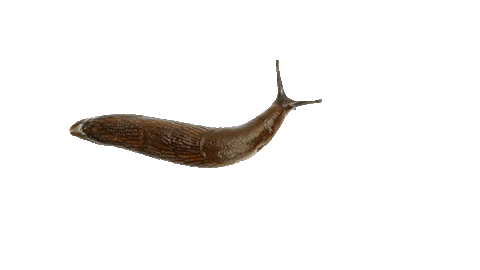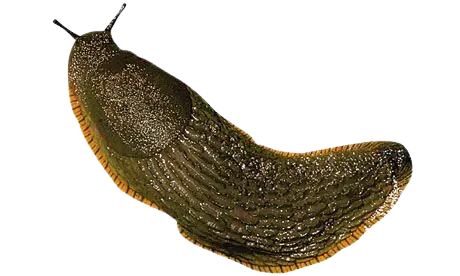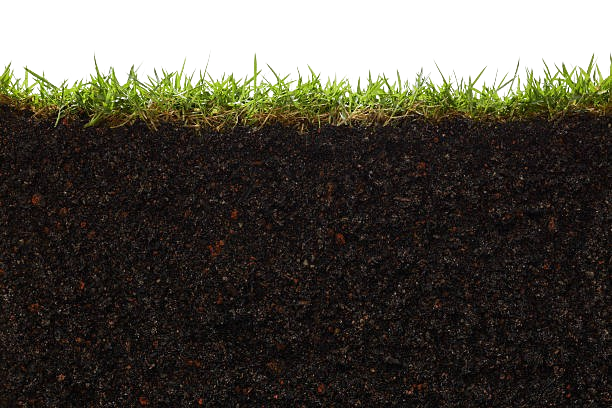
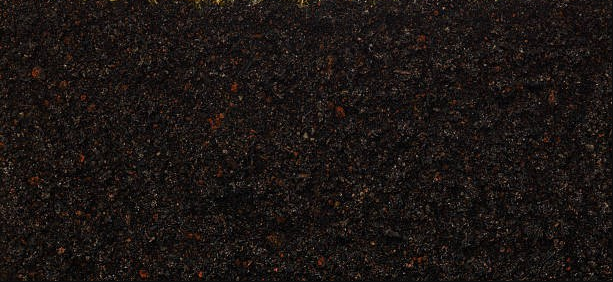





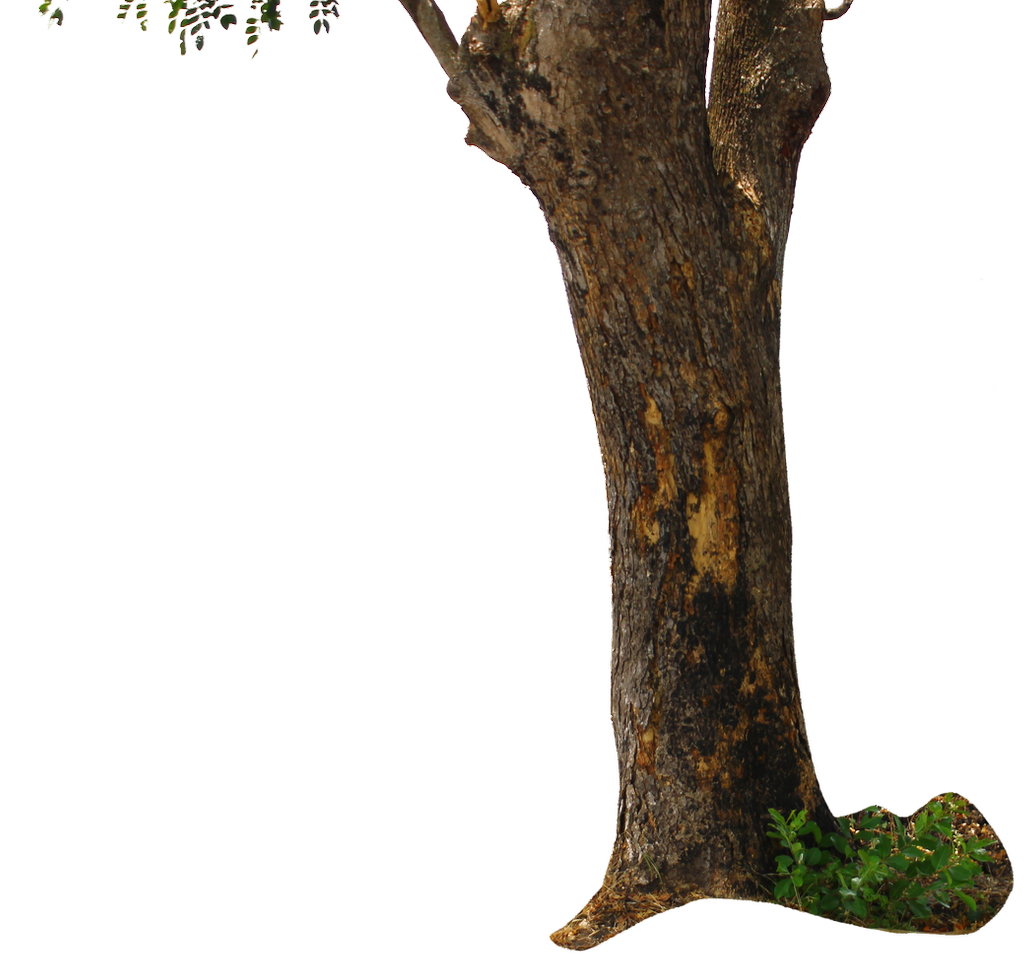
.png)
Emmy's Basic Slug Care Guide
GREETINGS!!!!! This is my guide for caring for slugs!!! I own and have owned many slugs and this is how I take care of them, as well as some useful information for you to use when making decisions about your slug care. I am in no way a professional so please do not solely rely on the info in this document to get a slug!!!
The First Step
The first thing you must do when you get a slug (if it's wild caught) is identify the species!! Slug care depends a little bit on the species, especially with diet and humidity. This document is just on general slug care, so if you want anything that is species-specific, send me a message and I will whip something up for you!
Here are some tools that are great for identifying slugs, as well as some good identification book recommendations.
Online tools:
The Terrestrial Mollusk Tool| developed and published by CPHST and other contributors
Land Snails and Slugs of the Mid-Atlantic and Northeastern United States
| created by the Carnegie Museum of Natural History
Books
Land Snails and Slugs of the Pacific NorthwestMore soon...
If you are interested in learning about the anatomy of your slug friends, here is a link to a page with good information on the topic. If you want to learn more, check out this page on the College of Agricultural Sciences at Oregon State University's webpage on slugs (and also maybe identify your slug there under the identification category!) Here is a basic diagram of slug anatomy for your viewing pleasure:
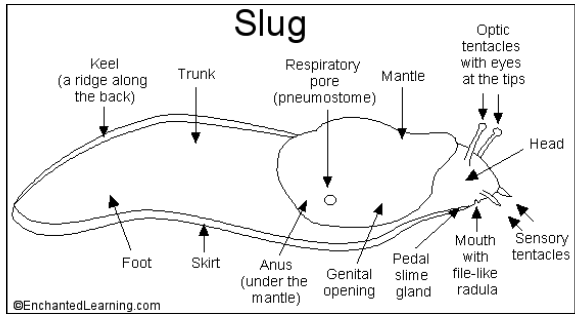
Section One: Slug Housing
Part one: the Tank
When housing slugs, you mostly have to make sure their tank is full of lots of things to do as well as having good humidity levels. Slugs have to have 65% humidity or higher to be healthy. They need about 2-3 gallons per slug (depending on the size). I usually keep my slugs in large tupperware bins with ventilation holes poked into the lids, or in a terrarium with a damp towel on top, and they are a good size and hold humidity very well. The slugs seem to like the bins the most though, as they can climb on all of the walls including the lid.
Here is a chart showing other options of housing, and how they rank.
| KEY
Very good Good Okay Bad |
All-Purpose Terrarium

|
Glass Reptile Terrarium

|
Large Storage Bin/Tupperware

|
Fishtank
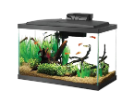
|
|---|---|---|---|---|
| Ventilation and Humiditity | BAD | All-Purpose terrariums are made for animals who need low humidity, so they have lots of ventilation and are very bad at holding humidity. If you'd like to use one of these, you have to cover most of the holes. | GOOD | Front opening reptile terrariums are very good for slugs, but most other reptile terrariums have screen lids, which will need to be covered by something like a towel to keep moisture in better. | VERY GOOD | Since tupperware bins come without built-in ventilation, you can add your own holes so the humidity and ventilation will be tailored to your needs perfectly. | OKAY | Fish tanks have built in ventilation while still having a solid lid, so they work alright. |
| Escapability Level | VERY LOW | All-purpose terrariums are made for small animals and insects, so a slug escaping is very unlikely. | LOW | Reptile terrariums are made so reptiles don't escape, so the slugs won't get out either. Some have holes that may need covered though. | VERY LOW | Since tupperware bins only have the small ventilation holes you have made, escaping is practically impossible unless the lid is loose. | HIGH | There are almost always lots of holes on the lids of fish tanks that slugs can get out of. Before use, they should be closed up. |
| Size | OKAY | Unless you buy a pretty large all-purpose terrarium, these will be too small for your slug to thrive in. They are mostly good for transportation. | VERY GOOD | Reptile Tanks are usually a very good size, and ones with front opening doors are good for accessibility. | VERY GOOD | Since you can get tupperware at any size, there are many that are large enough for the slugs to be happy and spacious inside. | GOOD | You can get fish tanks at any size, and they can be in many fun shapes as well. None of these have front opening doors, though. |
| Price | LOW | All-purpose terrariums can be found at any pet store and are very cheap. | HIGH | Reptile terrariums are very expensive unless bought second hand. | LOW upperware bins can be found at places like Walmart and other general stores for cheap with many variations. | HIGH | Fish tanks are also very expensive, especially fancy shaped or sized ones. |
Part two: Substrate
Once you have the housing selected for your slug, you need substrate. Any natural, pesticide free or natural substrate is good for slugs. I use cocoa fiber and sphagnum moss with the occasional mushroom topsoil mixed in, and it works very well with holding moisture, which is also essential for slugs.
Here is a chart showing info on substrates.
GOOD TO USE:
1. COCOA FIBER! | Cocoa fiber is the most popular choice for slug substrate. It is cheap, doesn't stink, and holds moisture well. It's sold in dehydrated and compressed bricks or loose in bags (I prefer the bricks) and is found at any pet store that has a reptile section. Once soaked in water and hydrated again, the fiber will be damp and nice for your tank.
2. TOPSOIL! | Topsoil is nice, but is a lot thicker than cocoa fiber, and is more prone to saturation without good ventilation. You can get it at garden centers, but you HAVE to make sure that is is completely natural, untreated, and plain. Chemicals in some topsoil can be very harmful to slugs. Don't get any topsoil with hydroballs or plant food, etc.
3. SOIL MIXES! | Soil mixtures made for reptiles such as frogs and toads work really well for slug tanks! Always double check what is in the mix, as well as its pH value (if listed) before you use it though.
BAD TO USE:
1. PEAT! | Peat is way too acidic in its pH value for slugs to live in. Most peat is also harvested in an unsustainable way.
2. COMPOST! | Compost is not good for slugs at all since it is most often made with loads of additives for gardening that will be harmful to your slug. Some are not like this though, and if you are able to find some free of any chemicals, it works similarly to topsoil.
Part three: Enrichment and decor
Slugs need to have some sort of enrichment in their tank. It is good to keep fresh leaves in the tank, as well as dead ones, as the slugs will eat both. My slugs seem to like the fresh leaves better. Slugs also love having rocks to climb on and go underneath, and terracotta pots. They also enjoy having moss, and sticks to hang off of. Unlike other pets, adding a water dish is not necessary. Slugs will drink the moisture that is inside their tank (if you are misting it enough). Remember to mist the tank frequently to keep moisture and humidity levels high. Finally, a food dish is very necessary. The slugs should have a designated place where they get their food. Some ideas of things to add to your slug tank that slugs will enjoy:
• Cork Bark
• Leaf Litter (dead and fresh)
• Fake Plants (no silk plants, they can be eaten)
• Mosses
• Sticks of varying lengths and heights
• Live Plants (see diet section)
• Terracotta pots or other clay hides
Section Two: Slug Diet
Part one: general diet
Your slugs should eat a large variety of foods. The food in the slugs tank should be replaced every day, or whenever it starts to get gross and is on the cusp of molding, which is about 1-2 days depending on humidity. You should always cut up the food to be small enough for the slug to eat, and wash the food thoroughly before preparation and feeding. Always buy farm fresh, as mass produced produce often has chemicals that are very bad for slugs. Slugs should be fed more veggies than fruits, as fruits have more sugars that are not as necessary to the slug as other things in veggies are. I will give fruits as part of their meal regularly though, as they still like it and need it. I will occasionally give jellies and jams that are low in sugar to my slugs as a treat on special occasions. When I have not much time to change the food in the tank or are too busy to change it every day, I feed them natural (low in sugar) fruit and veggie purees.
FOOD THAT IS GOOD FOR SLUGS
• Apples
• Strawberries
• Mushrooms
• Bananas
• Mango
• Blueberries
• Fish food (soak it in water)
• Cauliflower
• Broccoli
• Watermelon
• Cherries
• Raisins or grapes
• Cabbage
• Eggshells
• Carrots
• Watermelon
• Cucumber
• Spinach
• Zucchini
FOOD THAT IS GOOD FOR SLUGS (but they don't seem to like as much)
• Potatoes
• Asparagus
• Beetroot
• Red leafed lettuce
• Turnip
• Lamb's lettuce
• Tomatoes
• Peas
• Parsley
• Celery
• Leeks
FOOD THAT IS BAD FOR SLUGS
• Salt or anything at all salty
• Citrus like grapefruit, lemon, lime, orange, etc.
• Avocado
Part two: Calcium and Protein
Slugs do not have a need for as much calcium as snails do, since they do not have shells, but they still need foods with calcium in them, as well as a constant source of calcium. Keep a piece of cuttlebone in their tanks as well at all times, as it helps the slugs grow larger and have a consistent source of getting their calcium. Always give the slugs cuttlebone and not ever any other sources of calcium. The cuttlebone is easy to control, as your slug will only eat it when it wants to, but with calcium dust, crushed tums, etc. the slug could overdose.
Slugs can eat small amounts of high protein food like dog food and fish food. Some species will need more protein supplements and options in their diet than others (especially species that are partially or entirely predatory, make sure you know about your specie's diet before you adopt them), and some will even need to eat mealworms and other small bugs as part of their diet. When feeding fish food or dog food, make sure it is moistened with water until soggy and squished up into a jam-like consistency. When feeding bugs, they should never be alive.
Part three: Plants and home garden veggies
Some slug keepers like to keep plants in their slug's tanks that offer a food source when they are bored of what they are provided. Here are four lists of veggie plants, herbs, and flowers that are safe plants to put in their tanks, as well as a list of bad plants.
VEGGIE PLANTS THAT SLUGS LIKE TO EAT
• Any greens, like lettuce heads, spinach, etc.
• Most types of cabbage (Brussels sprouts, red cabbage, white cabbage, pointed cabbage, chinese cabbage, etc.)
• Strawberries (the fruit, not the leaves)
• Pepper Plants
• Pumpkin (young plants, rarely the fruits)
• Zucchini (the fruits)
• Cabbage Turnip
• Beans
• Mustard
• Celery (young plants especially)
• Buckwheat
• Cress
• Chili plants
• Lentils
• Radishes
• Carrots
• Asparagus
• please
HERBS THAT SLUGS LIKE TO EAT
• Basil
• Parsley
• Lemon verbena
• Dill
• Marjoram
FLOWERS THAT SLUGS LIKE TO EAT
• Marigolds
• Hostas
• Zinnias
• Delphiniums
• Lupines
• Dahlias
• Sunflowers
• Dandelions
• Bellflowers
• Asters
• Petunias
FLOWERS AND PLANTS THAT SLUGS DON'T LIKE/ARE BAD FOR THEM
• Fern
• Columbine
• Lavender
• Yucca
• Wormwood
• Lamb's ears
• Bugleweed
• Euphorbia
• Jacob's Ladder
• Japanese anemone
• Tree peony
• Foxglove
• Rosemary
• Cyclamen
• Hellebores
• Catmint
• Astilbe
• Nasturtium
• Penstemon
• Cranesbill geranium
• Ajuga reptans
• Astrantia
• Alchemilla mollisa
• Campanula
• Heuchera
• Crocosmia
• Cyclamen
• Fuscias
• Nasturtiums
• Hydrangeas
• Fennel
• Anise
• Rue
Section three: Cleanup Crew
Some people like to keep a cleanup crew in their tank with their slugs. I like to keep springtails with my slugs to clean up their tanks. Springtails are tiny white bugs that eat fecal matter and old food, as well as slug slime. They live in the soil and are harmless to your slugs. They can be found online or at some pet stores sold in little cups to release into your tank. I also use isopods in my tanks, but depending on the species, people worry that isopods will eat not just all of the things in the tank, but also the slugs (since isopods seem to decompose anything they come across). As long as you do research on the species you are getting, you should be fine.
